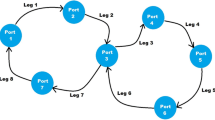Abstract
This article formulates the mathematical model of the liner shipping company cycle cost and attempts to optimize the operational profile of company assets in regards to specific network of routes of cargo flows and vessels portfolio. In other words it attempts to give a practical solution to the modern shipping company fleet deployment problem. This is achieved by developing a generic cost model methodology that aims to minimize total operating costs by using Genetic Algorithms in optimizing various predefined attributes such as operational speed. The finalized model could be applicable to liner shipping companies for optimization purposes of liner networks, as well as for simulation and examination of possible scenarios and what-if analysis. In the era of recession, a demand shock is examined and, interesting results are produced. In further research, this model can estimate the impact of environmental legislation intensification. In the what-if analysis, the model can depict how an initial design of a liner system can be optimized by modifying system attributes to dynamically meet new requirements.





Similar content being viewed by others
References
Alvarez, J.F. (2009) Joint routing and deployment of a fleet of container vessels. Maritime Economics & Logistics 11: 186–208.
Alvarez, J.F., Longva, T. and Engebrethsen, E.S. (2010) A methodology to assess vessel berthing and speed optimization policies. Maritime Economics & Logistics 12: 327–346.
Back, T. (1996) Evolutionary Algorithms in Theory and Practice: Evolution Strategies, Evolutionary Programming, Genetic Algorithms. Oxford: Oxford University Press.
Christiansen, M., Fagerholt, K., Nygreen, B. and Ronen, D. (2007) Maritime transportation. Invited chapter to In: C. Barnhart. and G. Laporte (eds.) Handbooks in Operations Research and Management Science, (Transportation), Vol. 14, pp. 189–284.
Cullinane, K. and Khanna, M. (1999) Economies of scale in large container ships. Journal of Transport Economics and Policy 33 (2): 185–208.
Fagerholt, K. (1999) Optimal fleet design in a ship routing problem. International Transactions in Operational Research 6 (5): 453–464.
Gillman, S. (1999) The size economies and network efficiencies of large containerships. International Journal of Maritime Economics 1 (1): 39–59.
Goldberg, D.E. (1989) Genetic Algorithms in Search, Optimization, and Machine Learning. Reading, MA: Addison-Wesley.
Holland, J.H. (1975) Adaptation in Natural and Artificial Systems. University of Michigan Press.
Jaikumar, R. and Solomon, M.M. (1987) The tug fleet size problem for barge line operations: A polynomial algorithm. Transportation Science 21 (4): 264–272.
Jansson, J.O. and Shneerson, D. (1978) Economies of scale of general cargo ships. The Review of Economics and Statistics 60 (2): 287–293.
Jansson, J.O. and Shneerson, D. (1982) The optimal ship size. Journal of Transport Economics and Policy 16 (3): 217–238.
Jansson, J.O. and Shneerson, D. (1987) Liner Shipping Economics. London: Chapman & Hall.
Jaramillo, D.I. and Perakis, A.N. (1991) Fleet deployment optimization for liner shipping. Part 2. implementation and results. Maritime Policy & Management 18 (4): 235–262.
McLellan, R.G. (1997) Bigger vessels: How big is too big? Maritime Policy & Management 24 (2): 193–19.
Mehrez, A., Hung, M.S. and Ahn, B.H. (1995) An industrial ocean-cargo shipping problem. Decision Sciences 26 (3): 395–423.
Mitchell, M. (2001) An Introduction to Genetic Algorithms. Cambridge, MA and London, England: The MIT Press.
Nulty, W.G. and Ratliff, H.D. (1991) Interactive optimization methodology for fleet scheduling. Naval Research Logistics 38: 669–677.
Palisade Corporation. (2009) Guide to Using Evolver the Genetic Algorithm Solver for Microsoft Excel Version 5.5. Ithaca, NY: Palisade Corporation.
Papadakis, N.A. and Perakis, A.N. (1989) A nonlinear approach to multi-origin, multi-destination fleet deployment problem. Naval Research Logistics 36: 515–528.
Perakis, A.N. and Jaramillo, D.I. (1991) Fleet deployment optimization for liner shipping. Part 1. background, problem formulation and solution approaches. Maritime Policy & Management 18 (3): 183–200.
Perakis, A.N. and Papadakis, N.A. (1987a) Fleet deployment optimization models. Part 1. Maritime Policy & Management 14: 127–144.
Perakis, A.N. and Papadakis, N.A. (1987b) Fleet deployment optimization models. Part 2. Maritime Policy & Management 14: 145–155.
Powell, B.J. and Perakis, A.N. (1997) Fleet deployment optimization for liner shipping: An integer programming model. Maritime Policy & Management 24 (2): 183–192.
Rawlins, G. (ed.) (1991) Foundations of Genetic Algorithms. Los Altos, CA: Morgan Kaufmann.
Winston, W.L. (1997) Operations Research Applications and Algorithms. Belmont, CA: Wadsworth Publishing Company.
Xinlian, X., Tangfei, W. and Daisong, C. (2000) A dynamic model and algorithm for fleet planning. Maritime Policy & Management 27 (1): 53–63.
Acknowledgements
Work on this article was carried out in the context of research project ‘Analysis of Optimal Containership Size and Its Impact on Liner Shipping Operations’ and was supported in part via a NOL Fellowship Program grant to the National University of Singapore (NUS) and the National Technical University of Athens (2008–2010). The authors would like to thank Professors T.F. Fwa and Meng Qiang of NUS for their collaboration in this project and Mr Cedric Foo and Capt. Alam Khorshed of NOL/APL for their assistance. We would further like to thank the Editor and the anonymous referees for their comments on previous versions of the manuscript.
Author information
Authors and Affiliations
Rights and permissions
About this article
Cite this article
Zacharioudakis, P., Iordanis, S., Lyridis, D. et al. Liner shipping cycle cost modelling, fleet deployment optimization and what-if analysis. Marit Econ Logist 13, 278–297 (2011). https://doi.org/10.1057/mel.2011.11
Published:
Issue Date:
DOI: https://doi.org/10.1057/mel.2011.11




